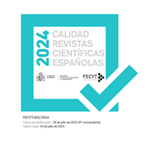Nuevas narrativas en los cibermedios: de la disrupción a la consolidación de formatos y características
Resumen
El periodismo digital ha vivido transformaciones constantes en sus primeros 25 años de historia, en los que la forma de contar historias ha cambiado conforme las diferentes especies del ecosistema aparecieron y se interrelacionaron. Superada una fase de significativa experimentación en los formatos narrativos adaptados al medio digital, es necesario evaluar los aspectos que permanecen y su evolución en la producción de los cibermedios. A partir del análisis de contenido en una selección de diez cibermedios y entrevistas con profesionales, se identifican los formatos y las características que se han desplegado con un desarrollo narrativo. Los resultados indican que existe una experimentación significativa que ha llevado determinados rasgos y formas de expresión de la disrupción a la consolidación, en función al grado de adopción e innovación, aunque todavía es extraordinaria la presencia de los proyectos multimedia e interactivos complejos en la oferta informativa cotidiana.
Descargas
Descarga artículo
Licencia
La revista Estudios sobre el Mensaje Periodístico, para fomentar el intercambio global del conocimiento, facilita el acceso sin restricciones a sus contenidos desde el momento de su publicación en la presente edición electrónica, y por eso es una revista de acceso abierto. Los originales publicados en esta revista son propiedad de la Universidad Complutense de Madrid y es obligatorio citar su procedencia en cualquier reproducción total o parcial. Todos los contenidos se distribuyen bajo una licencia de uso y distribución Creative Commons Reconocimiento 4.0 (CC BY 4.0). Esta circunstancia ha de hacerse constar expresamente de esta forma cuando sea necesario. Puede consultar la versión informativa y el texto legal de la licencia.










